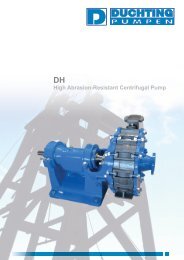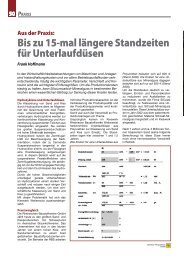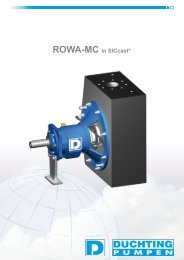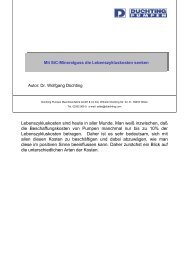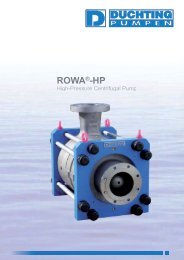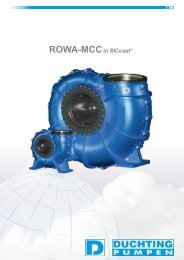Saving lifecycle costs through use of mineral ... - Düchting Pumpen
Saving lifecycle costs through use of mineral ... - Düchting Pumpen
Saving lifecycle costs through use of mineral ... - Düchting Pumpen
Create successful ePaper yourself
Turn your PDF publications into a flip-book with our unique Google optimized e-Paper software.
and <strong>mineral</strong> casting – show a linear<br />
interrelationship between wear and<br />
the velocity <strong>of</strong> the flow. The main<br />
observation is the significant<br />
difference in the dimension <strong>of</strong> wear.<br />
Starting at the lower flow velocities,<br />
the alloyed steel suffers wear several<br />
times higher than <strong>mineral</strong> casting.<br />
This phenomenon occurs over the<br />
whole test range in very similar<br />
proportions.<br />
Producing SICcast ®<br />
Going back to the early 1990s,<br />
<strong>Düchting</strong> Pumps started testing<br />
<strong>mineral</strong> castings by replacing single<br />
pump parts. After good results<br />
concerning wear and corrosion,<br />
<strong>Düchting</strong> founded a <strong>mineral</strong> casting<br />
company in 1994. This company,<br />
called SICcast ® , started<br />
manufacturing pumps with all wetted<br />
parts made <strong>of</strong> <strong>mineral</strong> casting,<br />
including volute casings, wear plates<br />
and impellers. Over the subsequent<br />
years SICcast ® achieved good results<br />
in several industries such as flue gas<br />
desulphurization, waste incineration<br />
plants, food industry, biochemistry,<br />
fertilizer plants, petroleum industries,<br />
glassworks, potassium mining and salt<br />
extraction, which are all well known<br />
for their corrosive and abrasive<br />
character.<br />
Silicon carbide (SiC) is artificially<br />
produced with a value <strong>of</strong> 9.6 on the<br />
Vickers hardness scale, which is the<br />
second highest value after diamond.<br />
In the past, SiC was only <strong>of</strong> <strong>use</strong> for<br />
fashioning simple shapes and smaller<br />
parts. This restriction was due to the<br />
fact that sintering was the only<br />
possible production method. In order<br />
to produce more complex parts for<br />
pumps, like impellers, parts have to<br />
be cast. This requires a binder<br />
material, in which particles <strong>of</strong> SiC<br />
are dispersed. Several tests and<br />
experiments finally led to the <strong>use</strong> <strong>of</strong><br />
an epoxy resin (EP) as the binder.<br />
The two materials are mixed in a<br />
ratio <strong>of</strong> approximately one part<br />
binder to four parts SiC. This process<br />
takes place under vacuum in order to<br />
get a bubble-free pour, which will be<br />
cast into highly precise moulds.<br />
feature feature chemical resistant pumps<br />
Figure 2. Comparison <strong>of</strong> wear.<br />
Threads are realized by means <strong>of</strong> cast<br />
parts that are placed in the moulds in<br />
advance. After a hardening process in<br />
the oven, the parts are de-moulded<br />
and are returned straightaway to the<br />
oven in order to be tempered. After<br />
that step the parts are ready for<br />
machining. Due to the material’s<br />
hardness, fittings are processed with<br />
diamond tools on the lathe. Thanks<br />
to the temperature-controlled casting<br />
process, which enables a secure and<br />
homogenous hardening process, parts<br />
<strong>of</strong> weight from 1 kg up to 8000 kg can<br />
be cast.<br />
<strong>Düchting</strong>’s process has been certified<br />
to ISO 9001 by Lloyd’s Register. The<br />
essential quality features are the<br />
measurement <strong>of</strong> the glass melting<br />
point and the test <strong>of</strong> the tensile<br />
strength with a test piece from every<br />
charge. With the storage <strong>of</strong> these<br />
pieces the results are traceable for an<br />
extended period.<br />
In Figure 3 the surface <strong>of</strong> the cast<br />
silicon carbide and epoxy resin<br />
material is shown magnified 50 times.<br />
By <strong>use</strong> <strong>of</strong> a certain particle size<br />
distribution curve, smaller and larger<br />
particles <strong>of</strong> silicon carbide (light) are<br />
achieved and surrounded by epoxy<br />
resin without any trapped air due to<br />
the technical vacuum in the mixing<br />
process. The binder appears dark after<br />
cauterizing the surface. Figure 3 also<br />
shows the chemical formula for the<br />
epoxy resin <strong>use</strong>d in the SICcast ®<br />
material.<br />
Figure 3. The<br />
components <strong>of</strong><br />
SICcast®.<br />
WORLD PUMPS May 2006 www.worldpumps.com 3



